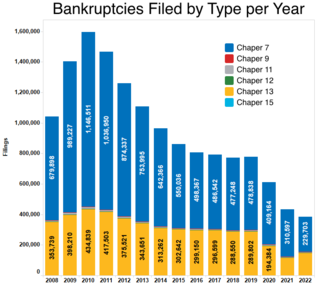Related Research Articles
Bankruptcy is a legal process through which people or other entities who cannot repay debts to creditors may seek relief from some or all of their debts. In most jurisdictions, bankruptcy is imposed by a court order, often initiated by the debtor.
Chapter 11 of the United States Bankruptcy Code permits reorganization under the bankruptcy laws of the United States. Such reorganization, known as Chapter 11 bankruptcy, is available to every business, whether organized as a corporation, partnership or sole proprietorship, and to individuals, although it is most prominently used by corporate entities. In contrast, Chapter 7 governs the process of a liquidation bankruptcy, though liquidation may also occur under Chapter 11; while Chapter 13 provides a reorganization process for the majority of private individuals.
Chapter 7 of Title 11 U.S. Code is the bankruptcy code that governs the process of liquidation under the bankruptcy laws of the U.S. In contrast to bankruptcy under Chapter 11 and Chapter 13, which govern the process of reorganization of a debtor, Chapter 7 bankruptcy is the most common form of bankruptcy in the U.S.
Debt restructuring is a process that allows a private or public company or a sovereign entity facing cash flow problems and financial distress to reduce and renegotiate its delinquent debts to improve or restore liquidity so that it can continue its operations.

In the United States, bankruptcy is largely governed by federal law, commonly referred to as the "Bankruptcy Code" ("Code"). The United States Constitution authorizes Congress to enact "uniform Laws on the subject of Bankruptcies throughout the United States". Congress has exercised this authority several times since 1801, including through adoption of the Bankruptcy Reform Act of 1978, as amended, codified in Title 11 of the United States Code and the Bankruptcy Abuse Prevention and Consumer Protection Act of 2005 (BAPCPA).

In accounting, insolvency is the state of being unable to pay the debts, by a person or company (debtor), at maturity; those in a state of insolvency are said to be insolvent. There are two forms: cash-flow insolvency and balance-sheet insolvency.

The Bankruptcy Abuse Prevention and Consumer Protection Act of 2005 (BAPCPA) is a legislative act that made several significant changes to the United States Bankruptcy Code.
A trustee in bankruptcy is an entity, often an individual, in charge of administering a bankruptcy estate.
A bankruptcy discharge is a court order that releases an individual or business from specific debts and obligations they owe to creditors. In other words, it's a legal process that eliminates the debtor's liability to pay certain types of debts they owe before filing the bankruptcy case.
Consumer bankruptcy in Canada is governed by the Bankruptcy and Insolvency Act ("BIA"). The legislation is complemented by regulations, as well as directives from the Office of the Superintendent of Bankruptcy that provide guidelines to trustees in bankruptcy on various aspects of the BIA.
Bankruptcy in the United Kingdom is divided into separate local regimes for England and Wales, for Northern Ireland, and for Scotland. There is also a UK insolvency law which applies across the United Kingdom, since bankruptcy refers only to insolvency of individuals and partnerships. Other procedures, for example administration and liquidation, apply to insolvent companies. However, the term 'bankruptcy' is often used when referring to insolvent companies in the general media.

The Bankruptcy and Insolvency Act is one of the statutes that regulates the law on bankruptcy and insolvency in Canada. It governs bankruptcies, consumer and commercial proposals, and receiverships in Canada.

The Enterprise Act 2002 is an act of the Parliament of the United Kingdom which made major changes to UK competition law with respect to mergers and also changed the law governing insolvency bankruptcy. It made cartels illegal with a maximum prison sentence of 5 years and states that level of competition in a market should be the basis for investigation.
Bankruptcy is a legally declared inability or impairment of ability of an individual or organization to pay their creditors. In most cases personal bankruptcy is initiated by the bankrupt individual. Bankruptcy is a legal process that discharges most debts, but has the disadvantage of making it more difficult for an individual to borrow in the future. To avoid the negative impacts of personal bankruptcy, individuals in debt have a number of bankruptcy alternatives.
The insolvency law of Switzerland is the law governing insolvency, foreclosure, bankruptcy and debt restructuring proceedings in Switzerland. It is principally codified in the Federal Statute on Debt Enforcement and Bankruptcy of 11 April 1889 as well as in ancillary federal and cantonal laws.
Bankruptcy in Irish Law is a legal process, supervised by the High Court whereby the assets of a personal debtor are realised and distributed amongst his or her creditors in cases where the debtor is unable or unwilling to pay his debts.

Commercial insolvency in Canada has options and procedures that are distinct from those available in consumer insolvency proceedings. It is governed by the following statutes:

British Virgin Islands bankruptcy law is principally codified in the Insolvency Act, 2003, and to a lesser degree in the Insolvency Rules, 2005. Most of the emphasis of bankruptcy law in the British Virgin Islands relates to corporate insolvency rather than personal bankruptcy. As an offshore financial centre, the British Virgin Islands has many times more resident companies than citizens, and accordingly the courts spend more time dealing with corporate insolvency and reorganisation.

Cayman Islands bankruptcy law is principally codified in five statutes and statutory instruments:
Anguillan bankruptcy law regulates the position of individuals and companies who are unable to meet their financial obligations.
References
- ↑ "Detailinformationen zur Publikation" (in German). Archived from the original on 30 December 2013. Retrieved 19 April 2014.
- ↑ "Discharge in Bankruptcy - Bankruptcy Basics". United States Courts. Administrative Office of the U.S. Courts. Retrieved 15 May 2017.
- ↑ "US Courts 2008 Bankruptcy Statistics (Excel)". uscourts.gov. Archived from the original on 2009-08-16. Retrieved 2023-03-14.
{{cite web}}: CS1 maint: bot: original URL status unknown (link) - ↑ "Medical bills trigger half of all bankruptcies - Business - Personal finance - NBC News". nbcnews.com. 2 February 2005. Retrieved 2023-03-14.
- ↑ Flynn, Ed (August 2017). "Bankruptcy by the Numbers" (PDF). ABI Journal: 38. Retrieved 14 March 2023.
- ↑ "Bankruptcy and the COVID-19 Crisis" (PDF). hbs.edu. Retrieved 2023-03-14.
- ↑ Zinger, Seffy. "Restructuring Israel's insolvency law". Restructuring Israel’s insolvency law. Retrieved 1 May 2020.
- ↑ EFRAT, RAFAEL. "THE TRANSFORMATION OF THE ISRAELI BANKRUPTCY SYSTEM AS A REFLECTION OF SOCIETAL CHANGES" (PDF). Florida State University. Archived from the original (PDF) on 15 September 2006. Retrieved 19 April 2014.